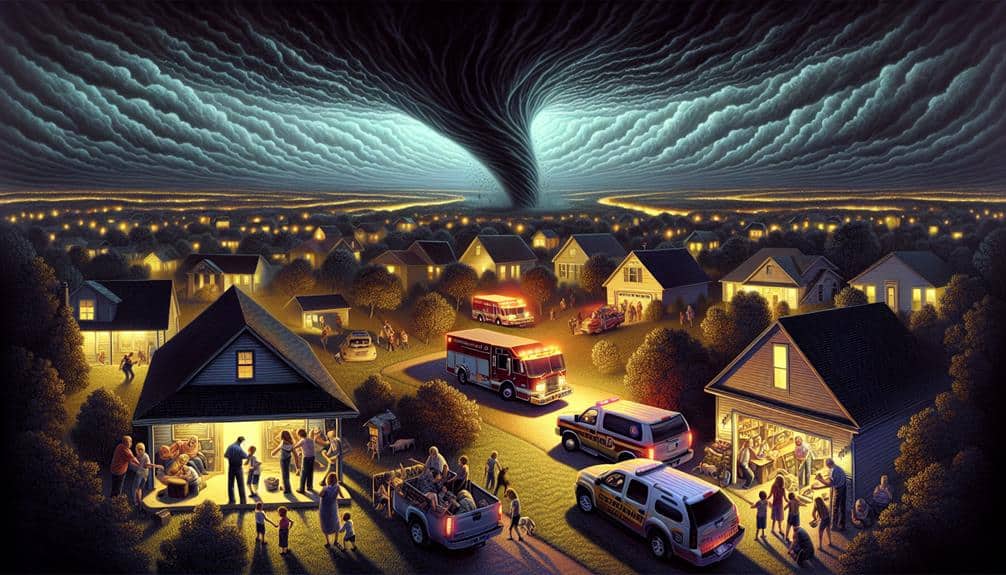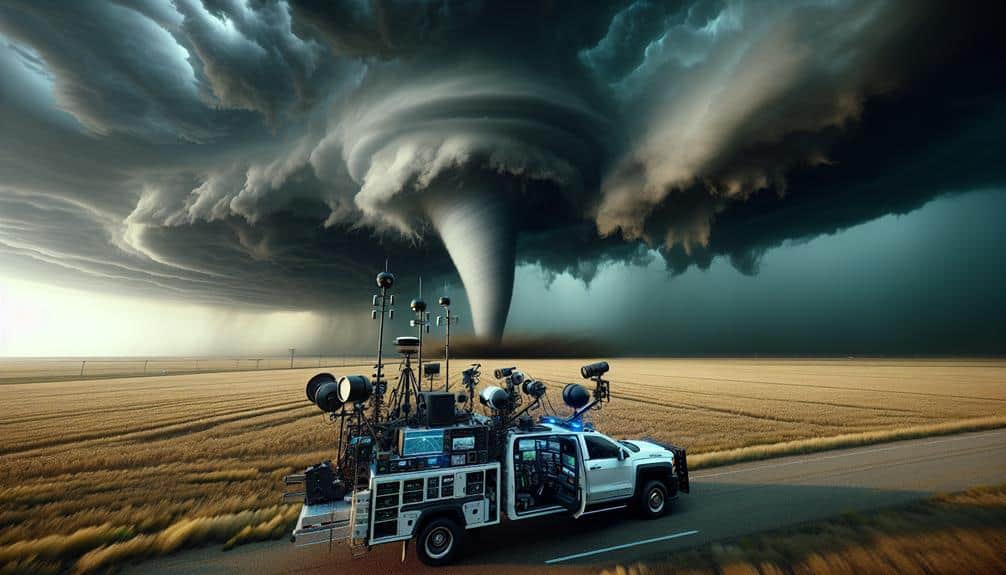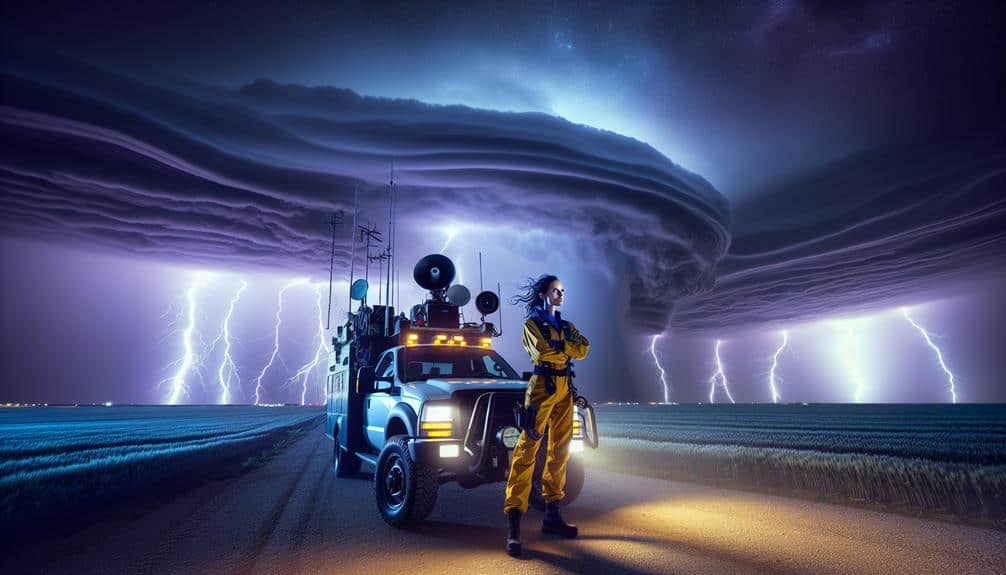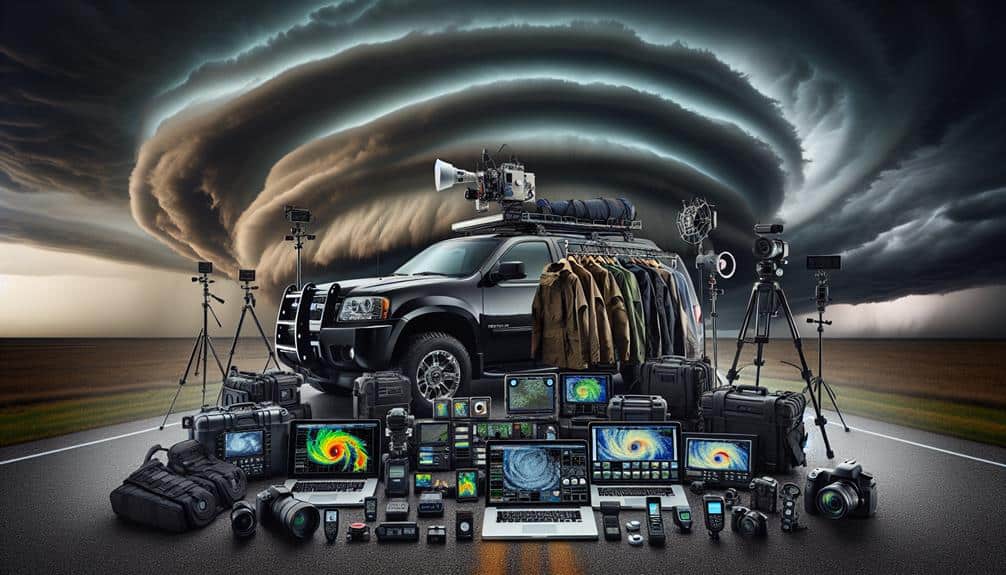Tornado Alley weather conditions are important for predicting and mitigating tornado impacts. Wind shear causes horizontal air spinning, and updrafts tilt this spinning vertically, creating tornado-prone supercell thunderstorms. The interaction between warm, moist Gulf air and cooler Rockies air generates atmospheric instability, often measured by CAPE. High dew point temperatures and low-pressure systems further elevate tornado risks. Seasonal peaks in spring and fall highlight the importance of these conditions, significantly affecting community safety and economic stability. Understanding these dynamics is essential for developing effective early warning systems and emergency protocols, ensuring we're better prepared for these destructive events.
Key Points
- Tornado Alley conditions produce frequent tornadoes due to the clash of Gulf and Rockies air.
- Wind shear and updrafts in Tornado Alley generate rotating storms essential for tornado formation.
- High dew points in Tornado Alley indicate moisture levels crucial for tornado development.
- Seasonal weather patterns in Tornado Alley lead to peak tornado activity in spring and fall.
Understanding Tornado Formation
To understand tornado formation, we need to analyze the atmospheric conditions that lead to their development. Tornadoes arise from severe thunderstorms, where specific atmospheric dynamics come into play. First, let's consider wind shear, which involves changes in wind speed and direction with altitude. This differential wind pattern creates horizontal spinning in the lower atmosphere.
Next, we need to examine the role of updrafts. Strong updrafts tilt the horizontally spinning air into a vertical orientation, essential for tornado formation. These updrafts are fueled by warm, moist air from the Gulf of Mexico meeting cooler, dry air from the Rockies. This collision sets up a boundary, known as a dryline, which is often the focal point for tornado genesis.
Additionally, we can't ignore the significance of instability in the atmosphere. Instability occurs when warm air near the surface is overlain by cooler air aloft, creating a buoyant environment. This buoyancy allows the updrafts to intensify and sustain themselves, fostering the development of supercell thunderstorms, which are the primary tornado producers.
Key Meteorological Indicators
Analyzing main meteorological indicators, we focus on parameters like wind shear, atmospheric instability, and moisture levels that provide essential insights into tornado potential.
Wind shear, the variation in wind speed and direction with altitude, is vital for the development of rotating thunderstorms. When wind patterns at different altitudes diverge significantly, they create the necessary environment for supercell formation, a precursor to tornadoes.
Atmospheric instability, quantified by parameters such as Convective Available Potential Energy (CAPE), indicates how buoyant air parcels are. High CAPE values suggest that air parcels can rise rapidly, fueling severe thunderstorms. By examining atmospheric pressure, we can gauge the likelihood of these unstable conditions. Low-pressure systems often signal the presence of rising air, enhancing instability and increasing the likelihood of severe weather.
Moisture levels, especially at low altitudes, are another important factor. Adequate moisture, often measured by dew point temperatures, provides the latent heat needed for storm development. When we observe high dew points in conjunction with favorable wind patterns and low atmospheric pressure, the risk of tornadoes escalates.
Seasonal Weather Patterns
Seasonal weather patterns in Tornado Alley display distinct variations that heavily impact tornado activity throughout the year. During spring, we observe a peak in tornado occurrences due to the convergence of warm, humid air from the Gulf of Mexico and cooler, arid air from Canada. This clash creates highly unstable atmospheric conditions, fostering the development of severe thunderstorms and tornadoes.
Summer months generally see a decline in tornado frequency, although isolated events still occur, particularly when remnants of tropical storms move inland.
Fall introduces a secondary peak in tornado activity, albeit less intense than in spring. The shift from summer heat to cooler autumn air can again create suitable conditions for storm formation.
Winter sees the least tornado activity, as the necessary warm, humid air is less prevalent.
Climate change plays a significant role in altering these seasonal patterns. We're witnessing changes in the timing and intensity of tornadoes, making storm tracking even more critical. Enhanced storm tracking technologies, such as Doppler radar and satellite imaging, allow us to monitor these changing patterns with greater accuracy.
As we adapt to these evolving conditions, understanding seasonal variations becomes indispensable for predicting and mitigating tornado risks effectively.
Impact on Local Communities
Local communities in Tornado Alley frequently face severe disruptions due to the volatile weather conditions, impacting everything from infrastructure to daily life. When tornadoes strike, they can decimate homes, schools, and businesses, leading to noteworthy economic implications. We must recognize that the cost of rebuilding efforts is substantial, often requiring federal aid and insurance payouts, which can strain public resources and delay recovery.
Community preparedness is essential. By investing in early warning systems and conducting regular drills, we can enhance our emergency response capabilities. Effective preparedness minimizes casualties and accelerates recovery processes. However, these measures demand continuous funding and public engagement to remain effective.
The economic implications extend beyond immediate damage. Businesses may shutter temporarily or permanently, disrupting local economies and employment. Infrastructure repairs can take months, hampering transportation and utilities, which are essential for any community's functionality. By prioritizing rebuilding efforts and ensuring they're swift and efficient, we can mitigate long-term economic downturns.
In essence, while Tornado Alley's weather conditions pose noteworthy challenges, proactive community preparedness and robust emergency response can greatly alleviate the adverse impacts, ensuring that our communities remain resilient and capable of bouncing back.
Safety Measures and Protocols

Given the substantial impact on local communities, implementing comprehensive safety measures and protocols becomes paramount in mitigating the effects of tornadoes. We must prioritize the establishment of sturdy emergency shelters designed to withstand the severe conditions characteristic of Tornado Alley.
These shelters should be strategically located and easily accessible to all residents, guaranteeing that no one is left vulnerable during a tornado event.
In addition to emergency shelters, well-developed evacuation plans are essential. These plans must include detailed routes and procedures for safely relocating individuals from high-risk areas to designated safe zones.
We need to conduct regular drills to make sure that every community member understands the evacuation plans, thereby reducing panic and confusion during actual emergencies.
Furthermore, integrating advanced meteorological technology for early warning systems can greatly enhance our preparedness. Real-time alerts allow us to activate these safety protocols promptly, giving residents the essential time needed to reach emergency shelters or follow evacuation plans.
Frequently Asked Questions
How Do Animals Behave Before a Tornado Strikes?
Animals exhibit remarkable pre-tornado behaviors. Their survival instincts kick in, showing heightened anxiety and restlessness. These warning signs, driven by animal instincts, suggest they sense atmospheric changes well before we do, enhancing their survival chances.
What Role Does Climate Change Play in Altering Tornado Alley Conditions?
As the climate dragon stirs, we witness climate change's impact reshaping Tornado Alley. Extreme weather patterns become more frequent, intensifying storms. We're analyzing these shifts to understand their implications on our freedom and safety in these regions.
Are There Any Famous Historical Tornadoes in Tornado Alley?
We've seen Tornado Alley's deadliest tornadoes, like the Tri-State Tornado, devastate regions. Their impact on communities includes significant loss of life, property damage, and long-term economic hardships, making historical awareness essential for future preparedness.
How Does Tornado Alley Compare to Other Tornado-Prone Regions Globally?
Tornado frequency in Tornado Alley far surpasses those in other regions globally. This significant surge stems from specific environmental impacts. While other areas face similar threats, they don't match the intensity and frequency seen here.
What Technological Advancements Are Improving Tornado Prediction Accuracy?
We're seeing significant improvements in tornado prediction accuracy thanks to advancements in satellite technology and Doppler radar. These tools enhance our ability to monitor atmospheric conditions, providing more precise, timely warnings, ultimately empowering communities with critical information.


